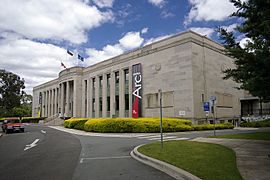Australian Institute of Anatomy facts for kids
Quick facts for kids Australian Institute of Anatomy (former) building |
|
|---|---|

The National Film and Sound Archive is now located in the former Australian Institute of Anatomy building.
|
|
| Alternative names | National Film and Sound Archive building |
| General information | |
| Status | Complete |
| Architectural style |
|
| Location | McCoy Cct, Acton, Canberra, Australian Capital Territory |
| Country | Australia |
| Coordinates | 35°16′59″S 149°07′16″E / 35.283°S 149.121°E |
| Current tenants | National Film and Sound Archive |
| Renovated | 1984; 1999; 2019 |
| Owner | Commonwealth of Australia |
| Technical details | |
| Material | Masonry; Hawkesbury sandstone |
| Floor count | 3 |
| Design and construction | |
| Other designers | E. Bruce (landscape) |
| Official name: Institute of Anatomy (former), McCoy Cct, Acton, ACT, Australia | |
| Type: | Listed place |
| Criteria: | A., B., D., F., G. |
| Designated: | 22 June 2004 |
| Reference #: | 105351 |
The Australian Institute of Anatomy was a special place in Canberra, Australia. It was a natural history museum and a research institute for medical studies. It opened in 1931 and closed in 1985.
Today, the same building is home to the National Film and Sound Archive (NFSA). This is where Australia's movies, TV shows, and music are kept safe. The building is very old and important, so it was added to the Commonwealth Heritage List in 2004.
The Institute started because a man named Colin Mackenzie wanted to study and protect Australia's native animals. He was worried they might disappear. He even helped start Healesville Sanctuary, a famous wildlife park. The Institute also looked after important items from Australian Institute of Aboriginal and Torres Strait Islander Studies. In 1984, the NFSA moved into the building.
Contents
Discovering the Building's Unique Style
The building is in Acton, Canberra. It has a main building, a garden area, and a house where the director used to live. The main building has a cool style called "Inter-war Stripped Classical." It also has amazing Art Deco designs.
These designs show off Australian animals, Aboriginal art, and famous scientists. You can see goannas, ferns, and waratahs carved into the entrance. The front door has stone carvings of frilled lizards. Blue and green patterns, like Aboriginal bark paintings, are under the windows.
Inside, the foyer has a beautiful marble floor with geometric shapes. The black marble came from Acton Peninsula, which is now under Lake Burley Griffin. There's even a platypus skylight! Masks of famous scientists are on the walls, reminding everyone of the building's past.
What Makes the Building Special?
This building was one of the first important public buildings in Canberra. It was built to help people learn more about Australia and to make Canberra a center for important collections. Colin Mackenzie was the first director, and the Institute became famous around the world.
The building was built using clever methods for its time. It had hollow blocks and special concrete floors. Since 1984, the National Film and Sound Archive has used the building. They work hard to save and share Australian films, TV, radio, and music.
The Archive keeps many cool things. These include old films, videos, audio tapes, and even old phonograph cylinders. They also have photos, posters, scripts, costumes, and props from movies and shows.
A Look at the Building's History
The building has been home to important collections for a long time. It first held Sir Colin MacKenzie's anatomy collection. This collection even included the heart of Phar Lap, a very famous Australian racehorse! When MacKenzie passed away in 1938, his ashes were placed in the building's foyer.
The building's style is often called Art Deco, but it's also known as "Inter-war Stripped Classical." This style was popular in the 1930s and 1940s. Buildings in this style often look balanced, with straight lines and a main entrance in the middle. They often use stone, like the Hawkesbury sandstone used here.
Famous Scientists Honored Here
The foyer walls have faces of twelve important scientists. Two of these are death masks, which are copies of their faces made after they passed away. These scientists were from different countries and worked in fields like anatomy, surgery, and natural history.
| Name | Lifetime | Nationality | Profession |
|---|---|---|---|
| Sir Harry Brookes Allen | 1854–1926 | Pathologist | |
| John Bell | 1763–1820 | Anatomist | |
| Charles Darwin | 1809–1882 | Naturalist | |
| George Britton Halford | 1824–1910 | Anatomist and physiologist | |
| William Harvey | 1578–1657 | Anatomist | |
| John Hunter | 1728–1793 | Surgeon | |
| Jean-Baptiste Lamarck | 1744–1829 | Naturalist | |
| Joseph Lister | 1827–1912 | Surgeon | |
| Louis Pasteur | 1822–1895 | Microbiologist and chemist | |
| Sir James Young Simpson | 1811–1870 | Obstetrician and anaesthetist | |
| Sir Edward Charles Stirling | 1848–1919 | Surgeon | |
| Sir Thomas Anderson Stuart | 1856–1920 | Physiologist |
Building Changes Over Time
In 1999, the National Film and Sound Archive needed more room. A large new section was added to the back of the building. This new part was designed to match the old Art Deco style perfectly.
Today, the building is open to everyone. It's a fantastic place to explore Australia's film, TV, and sound history. In 2019, the sandstone outside was even repaired to keep the building looking great.
Why This Building is Important
This building is very special to Australia. It was listed on the Register of the National Estate in 1980. Later, it was added to the Commonwealth Heritage List in 2004. These lists help protect important places for future generations.

